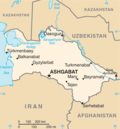Search results
Appearance
There is a page named "Afghan Turkmens" on Wikipedia
- Afghan Turkmens or Turkmens of Afghanistan (Persian: ترکمنهای افغانستان; Turkmen: اۇوغان تۆرکمنلری Owgan türkmenleri, [oʊˈɢɑn tʏɾkmønˈløɾʏ]) live in...7 KB (673 words) - 12:55, 12 March 2024
- north-western Afghanistan. Sizeable groups of Turkmens are found also in Uzbekistan, Kazakhstan, and the North Caucasus (Stavropol Krai). They speak the Turkmen language...81 KB (8,733 words) - 03:35, 13 June 2024
- among the modern Turkmens. Iranian Turkmens speak primarily Southern Turkmen, a variant of the Turkmen language also spoken in Afghanistan. It is currently...10 KB (1,077 words) - 21:47, 4 May 2024
- letters were abolished for sounds that are absent in the Turkmen language. The Turkmens of Afghanistan and Iran continue to use Arabic script. In January 1925...37 KB (2,262 words) - 17:49, 26 June 2024
- living in Iran Afghan Turkmens, Turkmen minority living in Afghanistan Turkmen in Pakistan, mostly Turkmen refugees from Afghanistan and Turkmenistan...4 KB (442 words) - 04:09, 5 June 2024
- Buddhism: Unknown Afghanistan portal Culture of Afghanistan Turks in Afghanistan Tajiks in Afghanistan Afghan Turkmens Afghan Kurds "Afghanistan Population (2021)...79 KB (3,364 words) - 13:19, 2 July 2024
- extinct in Afghanistan, but survives elsewhere. Afghanistan portal Afghan Turkmens Demographics of Afghanistan Ethnic groups in Afghanistan Turkic people...20 KB (1,564 words) - 00:23, 13 May 2024
- transformed Turkmen villages into giant sweatshops. Many Turkmen have claimed to be better off economically than the million or so Afghan refugees in...4 KB (382 words) - 18:46, 27 April 2024
- Afghanistan, mainly by Afghan Turkmens and Uzbeks. The industry is being expanded to all 34 provinces of Afghanistan. Afghan rugs have won a number of...8 KB (761 words) - 20:20, 16 June 2024
- people. The former Afghan National Anthem and the Afghan Constitution (before 2021) each mention fourteen of them. The term "Afghan" is synonymous with...69 KB (5,713 words) - 03:00, 19 June 2024
- Many Afghan rugs with the traditional Turkmen design are made by ethnic Turkmens living in this country. Afghanistan produces a lot of rugs, mainly for export...9 KB (913 words) - 17:19, 10 June 2024
- Uzbek, or Turkmen. Afghan Tatars claim descent from Tatar nomads who joined the Golden Horde and came to Afghanistan, first settling in Afghan Turkestan...7 KB (666 words) - 00:18, 31 May 2024
- Wary of Afghan Border, 16 August 2017, retrieved 8 September 2018 "Afghanistan's Central Asian neighbours panic, reject refugees". "More Turkmens Troops...10 KB (1,079 words) - 01:12, 14 May 2024
- Afghan Turkestan, also known as Southern Turkestan, is a region in northern Afghanistan, on the border with the former Soviet republics of Turkmenistan...6 KB (691 words) - 14:53, 28 April 2024
- Turkoman (ethnonym) (category Articles containing Turkmen-language text)the 11th century, Turkmens densely populated Arran. The 12th-century Persian writer al-Marwazi wrote about the arrival of Turkmens to Muslim lands, portraying...34 KB (3,457 words) - 12:25, 1 July 2024
- Saryk (category Articles containing Turkmen-language text)The Saryk (Turkmen: Sarykly) are a tribe of Turkmens in Turkmenistan. The Saryk mostly live in the valley of the Marghab River (the ancient Margiana)...6 KB (414 words) - 20:49, 17 September 2023
- Kyrgyz Akto Turkmen Afghan Kyrgyz Tajik Kyrgyz Van Kyrgyz Turkmen1 communities Turkmens Afghan Turkmens Ansarlu Iranian Turkmens Akto Turkmen Turkish communities2...14 KB (1,797 words) - 01:17, 23 June 2024
- War in Afghanistan, Afghan war, or Afghan civil war may refer to: Conquest of Afghanistan by Alexander the Great (330 BC – 327 BC), the conquest of Afghanistan...3 KB (456 words) - 18:24, 23 April 2024
- Turkmens Afghan Turkmens Qajars (tribe) Bichaghchi Turks in Afghanistan Turks in Libya Turks in Egypt Turks in Algeria Syrian Turkmen Iraqi Turkmen Turks...59 KB (5,652 words) - 12:24, 1 July 2024
- Wakhan Corridor to remain in Afghanistan. The western section of the border (i.e. the bulk of the modern Afghan–Turkmen boundary) was to be determined...9 KB (958 words) - 01:11, 14 May 2024
- demographic consequences of the Soviet intervention in Afghanistan Nationality: noun—Afghan(s); adjective—Afghan Ethnic divisions: 50% Pashtuns, 25% Tajiks, 9%
- stabilizing Islamic power. Their armies or those of their projecting allies, the Turkmens, Tatars and Maghreb corsair states extracted infidel captives on a grand
- geldiŋið]), or welcome, to the Turkmen Wikibook, perhaps the only learning resource available which can teach you the Turkmen language for free! Besides,












